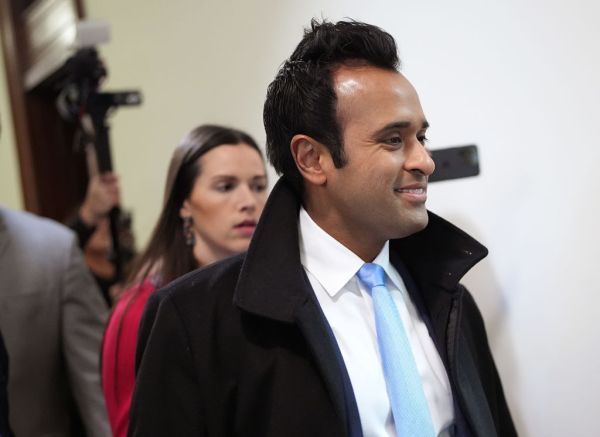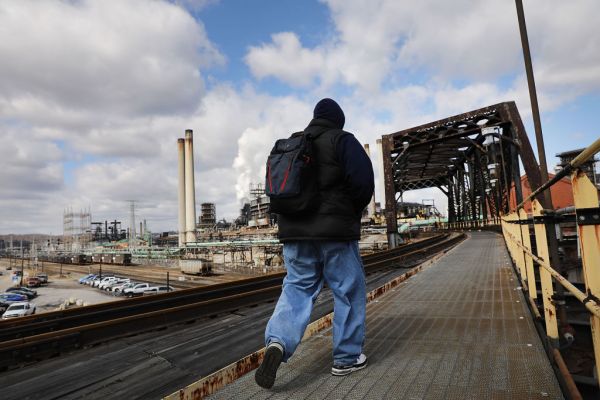I’m looking forward to breaking down the results on November 9 (the anniversary of the fall of the Berlin Wall and my birthday!) with Karl Rove and Joe Trippi. Get your tickets here! But before we get to that exciting conversation, there’s a lot that’ll happen in the next 24-48 hours (longer?) that’ll shape not only that discussion but the next several years of politics in America.
The information will be coming at warp speed and it can be a lot to take in. So allow me to serve as a guide of sorts to Election Night by sharing with you some of what I’ll be watching closely with the hope that it’ll help you make sense of the chaos. Feel free to pull this up on your laptop or your phone as you sit down to watch returns tonight. And, if you’re so inclined, join us for Dispatch Live at 10 p.m., where I’ll be checking in on some of these places to help us understand what’s happening.
The Presidential Race: 19 Counties to Watch
There are 3,141 counties (or the equivalent) in the United States, and 206 of them are considered pivot counties that flipped for Trump in 2016 after voting for Obama in 2008 and 2012. Below we’ll look at some of the most important counties to watch tonight—some of the top pivot counties, some of the swingiest counties, and some of the solid R or D counties where the candidates need to run up their margins to win the state.
Florida
Florida will be one of the first states to report results. Polls close at 7 p.m. ET in the majority of the state and 8 p.m. ET in the panhandle. Most importantly, they started counting their absentee ballots 22 days ago. The FiveThirtyEight polling average shows Biden up 2 points—within the margin of error—but the momentum has been with Trump. Trump does not have a realistic path to a second term without Florida; Biden does. Florida has 4 counties that flipped to Trump from Obama in both of his elections and we’ll look at each of them below.
Pinellas: Out of all the counties on this list and in this country, this is the one to watch for me, because if Trump wins Pinellas, he’s won Florida and we’re in for a long night (month?). This county is in the Tampa/St. Petersburg area, and with more than 450,000 votes up for grabs, it’s the largest of the counties in Florida that flipped for Trump. Obama won this county both times—by 8 in 2008 and by 6 in 2012—and Trump won it by just over a point in 2016. One recent poll of this county has Biden winning by over 13 points. But in 2018, Andrew Gillum, the Democrat running for governor, and Senator Bill Nelson, a Democrat running for reelection, both won this county—albeit by small margins—despite losing their elections.
St. Lucie: Tucked between Orlando and Miami on the Atlantic side, with around 150,000 voters, St. Lucie is part of what they call the Treasure Coast. Obama won this county by 12 in ’08 and 8 in ’12, and then Trump won it by just over 2 points in 2016. But just like Pinellas County, this county voted for both Gillum and Nelson in 2018.
Jefferson County: Unlike Pinellas and St. Lucie, Jefferson County, which neighbors Tallahassee on the east, flipped after going for Democrats in 2008 and 2012 and stayed that way in 2018. In fact, Trump won the county by 5 points in 2016, but Ron DeSantis, now the Republican governor of Florida, increased that lead and won it by almost 7 points two years later. Even though there are only around 7,000 voters in the county, it will be a bellwether that Trump will almost certainly need to win to stand a chance of taking the state.
Monroe County: Welcome to the Florida Keys. Believe it or not, these 35,000 or so voters may make the difference in 2020. Despite Obama’s back-to-back victories in the county, Trump won it by a comfortable 7 points. In 2018, Democrat Bill Nelson won the county by 16 votes (you read that correctly) and Republican Ron DeSantis won it by 1,333 votes. Keep an eye on this one; it could be a squeaker!
Pennsylvania
Polls close at 8 p.m. ET in Pennsylvania, but they don’t even start counting their absentee ballots until that morning. Because we expect more Democrats to vote by mail, if Joe Biden is winning Pennsylvania on election night, there’s a good bet his lead will only get bigger as mail ballot results trickle in. The FiveThirtyEight polling average shows Biden up five points, but he was leading by more than seven points just three weeks ago. Trump carried three Pennsylvania counties that Obama had won in 2008 and 2012, and we’ll look at each of them.
Erie County*: This is in the blue-collar manufacturing region in the northwest corner of the state. Obama won Erie by almost 20 points in 2008 and 16 points in 2012; Trump won it by 1.5 points in 2016. But then in 2018, the Democratic incumbent Bob Casey won it back and by 18 points—5 points more than his state total. On Tuesday, I’ll be watching Erie to see whether 2016 was just an anti-Hillary backlash or whether Democrats’ progressive rhetoric will cost Biden what clearly should be a reliable blue county.
Westmoreland County: This is part of the Pennsylvania fracking rainbow that starts in the Southwest corner of the state. Westmoreland sits just outside Pittsburgh—it’s big and it’s red. Republicans won the county in both 2008 and 2012, but Trump picked up an additional 13,000 voters from Romney, and Clinton lost nearly 4,000 voters from Obama’s 2012 performance, increasing his margin by more than 7 points. If Trump wins Pennsylvania, it’ll be because of big margins in Westmoreland, which is why Vice President Pence was there yesterday.
Luzerne County: This county is in the heart of the working-class, predominantly white northeast region of the state that delivered for Trump. Despite Obama winning the county by a healthy 8 point margin in 2008 and 4 points in 2012, Trump won it by a whopping 20 points just four years later. But Democrats showed signs of life in the midterms; Republican challenger Lou Barletta only won the county by 8 points over incumbent Senator Bob Casey in 2018. There is no realistic path for Trump to win PA without some healthy margins in Luzerne.
Northampton County: Here’s the closest we get to a true swing county in Pennsylvania. Until 2016, Northampton had voted for the Democrat in presidential elections and had voted for Republican and Democratic Senators like Rick Santorum, Pat Toomey, and Bob Casey. In fact, for both offices, as goes Northampton, so goes the state. But Northampton’s 7th congressional district has been reliably red for decades. Until 2018. The county went for Democrat Susan Wild by 6 points.
North Carolina
Polls close at 7:30 p.m. and they started counting mail ballots two weeks ago. North Carolina’s polling has Biden up by 1.9 but has consistently been within the margin of error according to the FiveThirtyEight polling average. There are 6 pivot counties in this state but they only account for about 3 percent of the state’s population. So even more important than those swing counties are the candidate’s abilities to juice turnout on their home turf. North Carolina didn’t have any statewide elections in 2018.
Union County: This is a perfect example of a Republican heavy suburban turnout county just outside Charlotte. Trump won Union County by 36.4 points in 2016 but the Republican lead was down to 20.5 points in the 2019 special congressional election. If Trump’s lead here is below 20, it will spell trouble for his chances to win the state.
Robeson County: This is a true pivot county that went for Obama by double digits in 2008 and 2012 and then flipped 23 points to vote for Trump in 2016, even though only 12 percent of voters were registered Republicans and 66 percent were registered Democrats. The demographics of this rural, former manufacturing county also aren’t what you might expect: “Of Robeson County’s 74,663 registered voters (as of mid-September), 35.1% are American Indian, 27.4% are Black and 28.5% are white.”
Cumberland County: Hillary Clinton underperformed Obama in this Fayetteville county by 4 points. It has a competitive congressional race (see NC-8 below) that could boost black turnout in a county that is 40 percent black. The Biden team will be carefully monitoring this county to gauge his support with black voters, hoping to see something closer to the 18-20 margin that Obama had.
Lenoir County: This tiny but mighty county has one of the best records in the country for predicting its state’s final result. Since 1992, it has deviated from the statewide result in North Carolina by only 1.17 points on average. In 2008 and 2012, Republicans won this county by less than a tenth of a point; Trump handily won it by 3.65 points.
Wisconsin
Polls close at 9 p.m. ET and they did not start counting mail ballots until this morning. The FiveThirtyEight polling average shows Biden up nearly 9 points and that lead has only increased in the past month. Trump won 23 Wisconsin counties that had voted twice for Barack Obama. But in 2018, Democrat Tony Evers beat incumbent Republican Governor Scott Walker by 1 point. We’ll look at 4 pivot counties below.
Winnebago County: This county sits in the Fox Valley, which the New York Times describes as “a three-county stretch from Green Bay to Oshkosh that is the most politically competitive region in one of America’s foremost battleground states.” Obama won this county by nearly 12 points in 2008, but in 2016, Trump carried it by 7 points. Walker overperformed in this county in 2018, winning it by 3 points.
Sawyer County: This northern vacation destination picks presidents. Sawyer voted for Obama, Bush, Clinton, and H.W. Bush. In fact, Sawyer has voted for the next resident of the White House every cycle since 1964. And in 2016, it wasn’t close. Trump won Sawyer with 56.7 percent compared to Hillary Clinton’s 38.3 percent. In 2018, despite incumbent Senator Tammy Baldwin winning the state by 11 points—Sawyer voted for her Republican opponent by 3 points.
Kenosha County: Trump won Kenosha by 238 votes. Before Trump, Richard Nixon was the last Republican president that this county supported. It’s the sort of manufacturing union county that used to be the backbone of the Democrat’s midwest blue wall and was home to racially-charged violence over the summer after a police shooting of a black man was captured on video. Trump will need to keep it competitive in Kenosha even if Biden wins it in the end. In 2018, Democratic gubernatorial candidate Evers easily outperformed his statewide margins, winning Kenosha by more than 4 points.
Crawford County: Trump carried Crawford by 417 votes in 2016—the first Republican to take the county since 1984. Tucked in the southwest corner of the state, the 16,000 residents of this mostly rural county are 94 percent white and focused on agriculture and trade policies. During the midterms, Democratic challenger Evers carried this county by more than 3 points.
Michigan
Polls close at 8 p.m. ET, but once again, we won’t have any results for mail ballots because they don’t start counting them until today. The FiveThirtyEight polling average shows Biden up over 8 points, and while any changes have been within the margin of error, late deciders look like they could be breaking toward Biden. Michigan might have been the most shocking state to flip to Trump in 2016 and for good reason—12 counties with over 18 percent of the state’s population flipped from Obama’s 08/12 ledger. But in 2018, the state easily elected Democrats for senate and governor. Hillary Clinton notoriously underperformed in some solid D counties in 2016. We’ll look below at where Biden will need to make up ground.
Wayne County: This is Detroit. It’s not a swing county and that’s putting it mildly. But here’s the problem: In 2016, Hillary won 66 percent of Wayne’s vote—a net loss of 76,000 votes from Obama’s total in 2012,when he won Wayne with 73 percent. Trump won Michigan by fewer than 11,000 votes. The Biden team will want to see him hitting over 70 percent this time around.
Macomb County: Now we move to the Detroit suburbs. As US News called it, Macomb is “the birthplace of the blue-collar Reagan Democrat.” Obama won it in 2012 with 52 percent, Trump won it back in 2016 with 54 percent. Digging into the numbers, you’ll see that Hillary Clinton lost 32,000 of those Obama voters and Trump picked up 33,000 more voters than Romney—nearly a one to one tradeoff. Biden’s job is to get them back.
Saginaw County: Here’s one of Michigan’s pivot counties. Obama won Saginaw by 17 percent in 2008 and 12 percent in 2012. Trump won it by just over a point in 2016. Interestingly, Trump only picked up just over 2,000 votes from Romney’s total in 2012. But Hillary bled nearly 10,000 votes from Obama.
Genesee County: Flint, Michigan, which Obama declared a federal state of emergency after high levels of lead were found in the water in 2015, sits in Genesee County. Obama won 64 percent over Romney’s 35 percent. But just four years later, Hillary Clinton squeaked out a win with only 52 percent, losing 26,000 of those Obama 2012 voters. Maybe that’s why Obama was there over the weekend to pitch Flinters on Biden and sank a shot on the high school’s basketball court, looking back to shout “that’s what I do” like it was no big deal.
The Senate: 15 Races to Watch
Republicans hold a three-seat majority in the Senate plus the tie-breaking vote of the vice president. To take the majority, Democrats will need to pick up a net of four seats or three seats and the White House. But the top of the ticket may control a lot of these races. As I explained last week:
Pew recently released a survey that showed 4 percent of voters intend to vote for a presidential candidate and a senate candidate from opposing parties. That’s down from 8 percent who split their ticket in 2016. This fits with everything we’ve been seeing about the decline of split ticket voters in general. As Pew noted, “In 139 regular and special elections for the Senate since 2012, 88% have been won by candidates from the same party that won that state’s most recent presidential contest.”
Sure, but that’s just a poll. We can also look back to 2016 to see which candidates outperformed Trump. In New Hampshire, Trump lost by .37 percent and Sen. Kelly Ayotte lost by .14 percent. Trump won Pennsylvania by .72 percent and Sen. Pat Toomey won by 1.43 percent. In North Carolina, Trump won by almost 4 points and Sen. Richard Burr won by 5. The only outlier worth mentioning appears to be Florida, in which Sen. Marco Rubio outperformed Trump by 6 points.
The Swing State Shuffle
Arizona: Republican appointee Martha McSally vs Democrat and retired NASA astronaut Mark Kelly.
Because this is a special election, the winner can be seated at the end of the month—well before other Senate winners, who will have to wait until January. Mark Kelly, a former Navy combat pilot and astronaut, is the husband of former congresswoman and gun control advocate Gabby Giffords, who was shot during an assassination attempt in 2011. McSally was the first U.S. woman to fly in combat and the first to command a fighter squadron. The race hasn’t had many game changing moments, but during a debate at the beginning of October McSally made headlines when she refused to answer whether she was “proud” of her support for President Trump. At a recent rally appearance with Trump, however, she tried to jerk-store an answer, declaring herself “a fighter who is proud to work with President Trump for the great American comeback.” Kelly has maintained a solid lead in nearly every poll this past month.
North Carolina: Republican incumbent Tom Tillis vs Democratic former state senator Cal Cunningham.
This race has been a rollercoaster even by 2020 standards. As Audrey reminded us in her piece this week, “just hours after Tillis told reporters he had tested positive for COVID-19 on October 2, news broke that Cunningham, a married father of two, was sending romantic text messages to a woman who is not his wife.” Tillis, for his part, has never been very popular in the state. “Tillis’ approval rating fell to just 53 percent among GOP voters in the first quarter of 2019, which coincided with Tillis’ decision to write a Washington Post op-ed in February of 2019 criticizing the president’s national emergency declaration for the border wall—before reversing himself and backing it.” Cunningham has been consistently leading in the polls since the summer and the race is currently just outside the margin of error in most polls.
Iowa: Republican incumbent Joni Ernst vs Democrat and commercial real estate executive
Theresa Greenfield.
This race has gotten tense. Ernst had an embarrassing flub at a recent debate where she couldn’t answer the going price for soybeans. But the Des Moines Register summed up the last few weeks in which “Ernst has played to her base, appearing with President Donald Trump at a rally in Omaha earlier in the week, airing television ads that falsely accuse Greenfield of calling police officers racists and doubling down on her arguments that Greenfield is far too liberal on issues like the environment and health care.” And it seems like it’s worked. In the final Des Moines Register poll, the gold standard in Iowa, Ernst was up 4 percent over Greenfield.
Georgia: Remember, there are two races here.
First, Republican incumbent David Perdue vs Democrat Jon Ossoff, best known for spending $30 million to succeed Tom Price in the most expensive House race in U.S. history, only to lose to Karen Handel by 5 points in 2017. Polls have bounced back and forth in this race with Ossoff closing the margin in the last couple weeks. Now it’s the closest race on the map.
Next up, the special election with Republican appointee and business executive Kelly Loeffler against the world. Bear in mind, every candidate—Republican and Democrat—runs on the November ballot and if no candidate receives more than 50 percent, there’s a runoff in January 2021. Democrats have consolidated behind Raphael Warnock, senior pastor at the Ebenezer Baptist Church. Loeffler, on the other hand, is trying to fend off a challenge from the right from Rep. Doug Collins even to make it into the runoff.
The Last Best Hope for GOP Pickups
Michigan: Democratic incumbent Gary Peters vs Republican and veteran John James.
One of the few potential pickups for Republicans this year, James has long been considered a rising star as a black, young, charismatic Republican who can speak to the moment of racial tensions in the country while Peters has never been the darling of his party. James was the Republican nominee against Sen. Debbie Stabenow in 2018, losing that race by seven points. This was always an uphill battle for the GOP and polling confirms Peters is comfortably leading James in all but one state poll this past month. Still, Peters seems to be underperforming Biden in the state, making James’ best chance of winning that Trump somehow closes the gap to within a point or two of Biden and James can outperform him just a little.
Alabama: Democratic incumbent Doug Jones vs Republican and former Auburn football coach Tommy Tuberville.
This will likely be the reason Democrats need four (plus White House) or five seats to take back the majority. On the one hand, Democrats had no business picking up a senate seat in deep red Alabama in 2018 after Jeff Sessions was confirmed as Attorney General, but Republicans can thank Roy Moore for that one. And at least two polls have Tuberville winning by double digits. But if Democrats have any hope of holding onto his seat, it will be because there are very few polls in the state and Tuberville wasn’t able to consolidate his money or support after being forced into a runoff with Jeff Sessions who failed to reclaim the seat he had held for 20 years. Assuming Jones loses, look for Biden to find him a soft landing in his administration if he wins.
Minnesota: Democratic incumbent Tina Smith vs former Republican congressman Jason Lewis
Like Michigan, this one is an unlikely GOP pickup, but Trump only lost Minnesota by 1.5 percent—just under 45,000 votes. Smith is relatively unknown in the state after just two years in office and Minneapolis City Council’s visible (if inconsequential) pledge to defund its police department (which Smith didn’t sign, but which was widely perceived to be a Democratic brainchild) didn’t help. Then again, Lewis isn’t the most compelling candidate the GOP fielded this year. As a former radio talk show host he has plenty of controversial statements that have come back to bite him in the land of Minnesota Nice. Bottom line: she’s raised more money and she’s still leading in every poll, but if Trump wins the state, Lewis could definitely pull it out.
The Blue State Blues
Colorado: Republican incumbent Cory Gardner vs Democratic former Governor and presidential candidate John Hickenlooper
Most analysts have written this race off. Hickenlooper is on track to win this race by double digits based on polls last month. Colorado isn’t a presidential battleground state for the first time in a few cycles, which may mean lower turnout, in which case Gardner could make it more competitive. Even so, Hickenlooper raised $23 million last quarter—three times as much money as Gardner—so it’s hard to see how the GOP can hold onto this one.
Maine: Republican incumbent Susan Collins vs Democratic state representative Sara Gideon
Like Colorado, Maine is another senate seat that most people are already putting in the Democrat’s column. Gideon is well known in her state as Speaker of the House. But there aren’t a lot of polls in the state and a few recent ones show Collins ticking up in the final stretch and within the margin of error. Collins raised $8 million last quarter, a record for her, but Gideon hauled in $39 million and started October with more than three times as much cash on hand.
The Red State Shockers
Montana: Republican incumbent Steve Daines vs Democratic governor and presidential candidate Steve Bullock
It’s the battle of the Steves. Like Colorado, a relatively new Republican incumbent is running against a popular former governor and former presidential candidate. But unlike Colorado, Montana is a quirky deep red state that nevertheless sometimes elects Democrats. The polls last month showed a true toss up. Is this the race where Trump—who won Montana by 20 points in 2016—will pull a candidate over the finish line?
Kansas (open): Republican congressman Roger Marshall vs Democratic state senator Barbara Bollier
Already the most expensive senate race in state history, Bollier has wildly outraised Marshall $24 million to $6 million. A battle of the moderates, Bollier is a former Republican, and Marshall defeated far-right immigration hawk Kris Kobach in the primary. Good polls are few and far between here but there’s a few that show Bollier eking out a win and some others with Marshall comfortably ahead in the state Trump won by 21 points in 2016. This is almost certainly one of those races that will rise or fall on Trump’s coattails with wobbly Republicans in the state.
South Carolina: Republican incumbent Lindsey Graham vs Democrat and former lobbyist Jamie Harrison
Of the races nobody saw coming, this is the most shocking in some ways. Even though Trump won the state by 14 points last time around, the polling should not make the Graham team feel comfortable—half a dozen in the past month show Harrison even or winning outright. And then there’s the $57 million Harrison raised last quarter—roughly double Graham’s haul—which can buy a lot of name ID in the relatively cheap media markets in the state. As Senate Judiciary chairman, vocal Trump supporter, and serving in elected office since 1993, Graham is a well known commodity. In short, this may be the only race in the country that isn’t a referendum on Donald Trump.
Texas: Republican incumbent John Cornyn vs Democrat and veteran pilot MJ Hegar.
She’s no Beto. But that’s all the more reason why MJ Hegar’s rise in the polls in Texas is raising eyebrows. She hauled in 8 times more money last quarter than the previous one and polls show her closing the gap—although as of today not a single poll has shown her winning the race. As unlikely as it may seem, if Hegar—a political unknown—comes even close to beating the former No. 2 in the Senate, John Cornyn—the blue wave will knock out a lot of lower ballot folks in the Lone Star State. Then again, we’ve heard predictions of a “blue Texas” for a decade now and Trump won the state by 9 points four years ago.
Alaska: Republican incumbent Dan Sullivan vs Independent and orthopedic surgeon Al Gross
This is certainly the most fun race in the country. Maybe it’s because the Alaska Democratic Party’s nomination didn’t go to a member of their own party (though Gross has said he will caucus with the Democrats). Or maybe it’s because one of the most controversial issues in the campaign was whether Gross actually killed a grizzly bear (he did). Or maybe it’s just this “Bear Doctor” jingle that everyone in Alaska has been subjected to for weeks now. Regardless, most polls show Sullivan—a native of Ohio, as Gross is quick to point out—winning a second term but it’s relatively close in a state that Trump won by 15 points in 2016.
House: 4 Races to Watch
Since this is my newsletter and I don’t believe Republicans have any chance of regaining the majority in the House (20 seats? I don’t think so!), I’m not actually interested in many of the “toss up” races. (If you are, you can read about them here and here.) Instead, the only reason I care about House races tonight is to figure out what they mean further up the ticket. Republicans are listed first, Democrats second, and I’ve linked to a good story in the “vs” for each one. In that spirit, here are the ones I’ll have tabs open for:
TX-21: Chip Roy* vs Wendy Davis
NE-2: Don Bacon* vs Kara Eastman
NC-8: Richard Hudson* vs Patricia Timmons-Goodson
IA-4 (open): Randy Feenstra vs J.D. Scholten
PA-10: Scott Perry* vs Eugene DePasquale
*Incumbent
Correction, November 3, 2020: An earlier version of this newsletter conflated two Pennsylvania counties: Erie County and Westmoreland County.









Please note that we at The Dispatch hold ourselves, our work, and our commenters to a higher standard than other places on the internet. We welcome comments that foster genuine debate or discussion—including comments critical of us or our work—but responses that include ad hominem attacks on fellow Dispatch members or are intended to stoke fear and anger may be moderated.
You are currently using a limited time guest pass and do not have access to commenting. Consider subscribing to join the conversation.
With your membership, you only have the ability to comment on The Morning Dispatch articles. Consider upgrading to join the conversation everywhere.